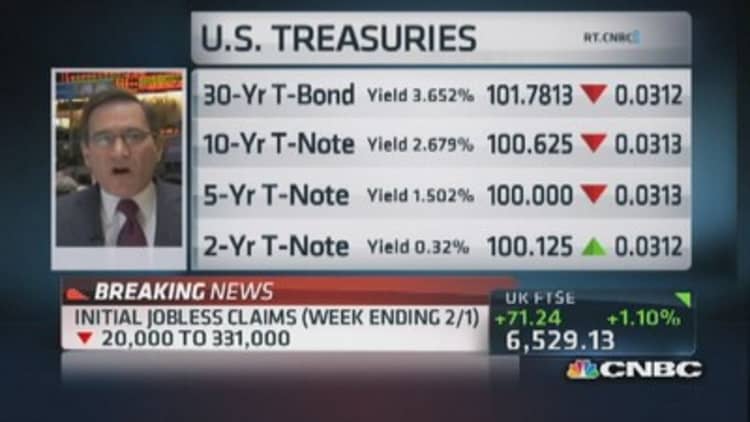
The number of Americans filing new claims for unemployment benefits fell more than expected last week, in a boost to the labor market outlook and the broader economy.
Initial claims for state unemployment benefits declined 20,000 to a seasonally adjusted 331,000, the Labor Department said on Thursday. Claims for the prior week were revised to show 3,000 more applications received than previously reported.
Economists polled by Reuters had forecast first-time applications for jobless benefits falling to 335,000 in the week ended Feb. 1.
The four-week moving average for new claims, considered a better measure of underlying labor market conditions as it irons out week-to-week volatility, nudged up 250 to 334,000.
A Labor Department analyst said claims for Kansas were estimated and there were no special factors affecting the state level data.
The data has no bearing on January's employment report, which will be released on Friday, as it falls outside the survey period. Hiring is expected to have accelerated in January after being held down by unseasonably cold weather the prior month.
Nonfarm payrolls likely increased 185,000 last month, up from December's tepid 74,000 count, according to a Reuters poll of economists. The unemployment rate is forecast to hold steady at a five-year low of 6.7 percent.
The claims report showed the number of people still receiving benefits under regular state programs after an initial week of aid increased 15,000 to 2.96 million in the week ended Jan. 25.
The so-called continuing claims have been elevated in recent weeks and some economists say the cold weather could be preventing many recipients from going out to search for work and companies to delay hiring.
Productivity beats as trade gap widens
Separately, U.S. nonfarm productivity rose more than expected in the fourth quarter, mirroring the economy's sturdy growth pace, but weak unit labor costs pointed to subdued wage inflation. Meanwhile, the trade deficit widened more than expected in December as exports fell, which could see the advance fourth-quarter growth estimate trimmed.
Productivity rose at a 3.2 percent annual rate after increasing at a 3.6 percent pace in the third quarter, the Labor Department said. Economists polled by Reuters had forecast productivity, which measures hourly output per worker, rising at a 2.5 percent rate in the last three months of 2013.
Still, the underlying trend remained soft, with productivity increasing 1.7 percent compared to the same period in 2012. For all of 2013, productivity increased 0.6 percent. That was the smallest gain since 2011 and compared to a 1.5 percent rise in 2012.
Unit labor costs - a gauge of the labor-related cost for any given unit of output - fell at a 1.6 percent rate in the fourth quarter, showing weak wage-related inflation pressures in the economy. Unit labor costs fell at a 2.0 percent rate in the third quarter.
The Commerce Department said the trade gap increased 12 percent to $38.7 billion. November's shortfall on the trade balance was revised to $34.6 billion from the previously reported $34.3 billion. Economists polled by Reuters had forecast the trade deficit widening to $36.0 billion in December. For all of 2013, the trade deficit was $471.5 billion, the smallest since 2009.
When adjusted for inflation, the trade gap rose to $49.5 billion in December from $45.0 billion the prior month. This measure goes into the calculation of gross domestic product. The government in its advance fourth-quarter GDP estimate last week cited trade as one of the key contributors to the economy's 3.2 percent annual growth pace during the period.
--By Reuters

